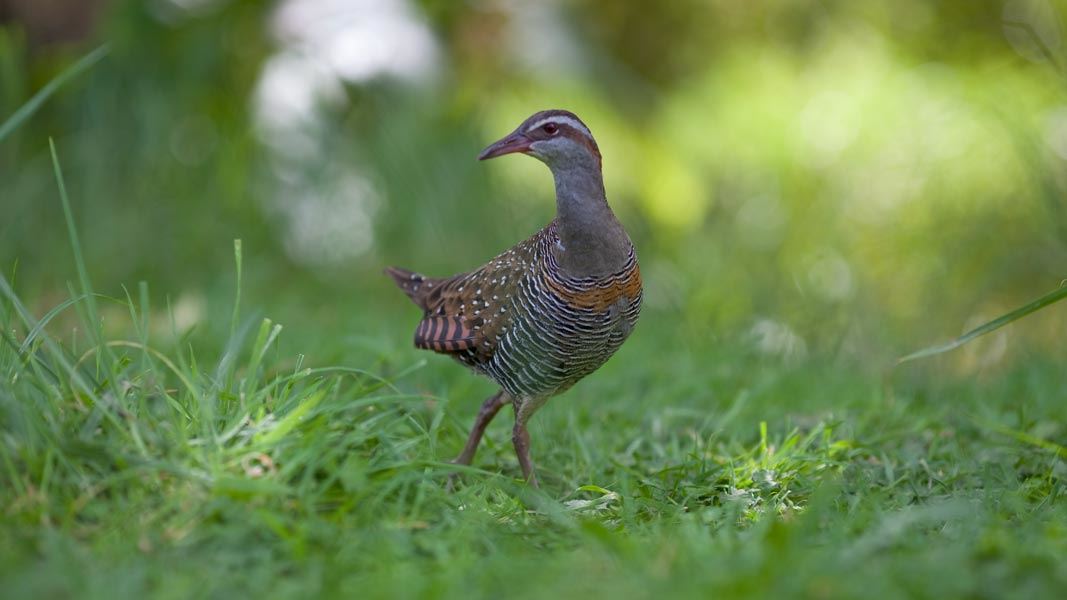New Zealand status: Native
Conservation status: At Risk–Declining
Found in: Sparsely throughout New Zealand; mainly in mangroves and salt marshes of the upper North Island
Threats: Habitat loss, predation, road-kills, human disturbance
Species information: Banded rail on NZ Birds Online
Image gallery
Banded rail conservation
Emergency hotline
Call 0800 DOC HOT (0800 362 468) immediately if you see anyone catching, harming or killing native wildlife.
The banded rail, or moho pererū as it is known to Maori, are similar to a weka, but not as large. They are usually quite shy but may become very tame and bold in some circumstances, as they have become on Great Barrier Island.
Declines in population
Banded rail are sparsely distributed on the three main islands and many small offshore islands. When Europeans arrived in New Zealand, banded rails were abundant, but regional and local populations have undergone declines.
They were once widely scattered throughout New Zealand. They have now disappeared from almost all of the South Island and now only occur in the saltmarshes in Nelson and Marlborough. Over the last 40 years they appear to have disappeared from the lower half of the North Island.
In northern North island they are confined to freshwater wetlands, mangroves, saltmarshes and shrublands (particularly in Northland and the Coromandel). Where they occur on offshore islands, they are also found in forests.
Habitat loss
Habitat clearance and drainage have had a significant impact on banded rails. Over 90% of lowland wetlands have been drained and cleared for agriculture since Europeans settled New Zealand. Degradation of the remaining wetlands continues with grazing, water pollution and taking of water for other uses being major threats.
Banded rail are a potential indicator of wetland health because they are dependent on the presence of high quality and ecologically diverse habitats and rich food supplies.
Coastal development, including mangrove removal and construction of marinas, result in habitat modification and the loss of food supplies for banded rail.
Management tools
Wetlands support a wide range of threatened bird species in New Zealand. However, management techniques for restoring their populations are poorly developed.
DOC is focusing on developing methods for surveying banded rails systematically. These methods will enable people to establish baseline data and distribution maps; identify important wetland habitat types for conservation and measure the response to management such as pest control; and habitat maintenance and restoration.
DOC has been developing ‘call counts’ for banded rails. These take place with either an observer listening for set times at dawn or dusk using call lures, or with new automatic recorders (electronic recorders developed by the DOC Electronics Lab) recording calls remotely.
In addition DOC is actively developing methods for restoring wetlands through its Arawai Kākāriki wetland restoration programme. Restoration involves developing a wide range of management tools including methods for controlling introduced predators, methods for managing water levels and restoring wetland vegetation.
Translocations
DOC and our partners have been involved in several translocations of banded rails: two to predator free offshore islands (Moturoa and Kundy Islands) which were successful; and two to mainland sites (Cape Sanctuary and Whangamarino wetland). Because banded rails are extremely cryptic, it is unknown if these were successful.
Predator control
Predators such as cats, dogs, mustelids, and rats are a major problem for banded rails. Setting up intensive predator trapping at wetlands that support banded rails is likely to help restore populations.
Read the review article:
Impacts of introduced mammalian predators on indigenous birds of freshwater wetlands in New Zealand
You can help
Report sightings or calls of banded rails to the nearest DOC office.
Get involved with the Tasman Environment Group in the Battle for the Banded Rail.
